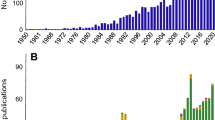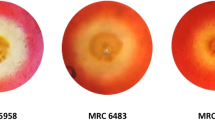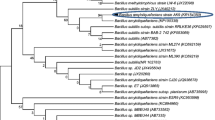Abstract
A potentially novel aerobic, thermophilic, and cellulolytic bacterium designated as Brevibacillus sp. strain JXL was isolated from swine waste. Strain JXL can utilize a broad range of carbohydrates including: cellulose, carboxymethylcellulose (CMC), xylan, cellobiose, glucose, and xylose. In two different media supplemented with crystalline cellulose and CMC at 57°C under aeration, strain JXL produced a basal level of cellulases as FPU of 0.02 IU/ml in the crude culture supernatant. When glucose or cellobiose was used besides cellulose, cellulase activities were enhanced ten times during the first 24 h, but with no significant difference between these two simple sugars. After that time, however, culture with glucose demonstrated higher cellulase activities compared with that from cellobiose. Similar trend and effect on cellulase activities were also obtained when glucose or cellobiose served as a single substrate. The optimal doses of cellobiose and glucose for cellulase induction were 0.5 and 1%. These inducing effects were further confirmed by scanning electron microscopy (SEM) images, which indicated the presence of extracellular protuberant structures. These cellulosome-resembling structures were most abundant in culture with glucose, followed by cellobiose and without sugar addition. With respect to cellulase activity assay, crude cellulases had an optimal temperature of 50°C and a broad optimal pH range of 6–8. These cellulases also had high thermotolerance as evidenced by retaining more than 50% activity at 100°C after 1 h. In summary, this is the first study to show that the genus Brevibacillus may have strains that can degrade cellulose.








Similar content being viewed by others
References
Atlas RM (2004) Handbook of microbiological media, 3rd edn. CRC press, Boca Raton
Barr BK, Hsieh YL, Ganem B, Wilson DB (1996) Identification of two functionally different classes of exocellulases. Biochem 35:586–592. doi:10.1021/bi9520388
Demain AL, Newcomb M, Wu JHD (2005) Cellulase, clostridia, and ethanol. Microbiol Mol Biol Rev 69:124–154. doi:10.1128/MMBR.69.1.124-154.2005
Doi RH, Kosugi A, Murashima K, Tamaru Y, Han SO (2003) Cellulosome from mesophilic bacteria. J Bacteriol 185:5907–5914. doi:10.1128/JB.185.20.5907-5914.2003
Doi RH, Kosugi A (2004) Cellulosomes: plant-cell-wall-degrading enzyme complexes. Nat Rev Microbiol 2:541–551. doi:10.1038/nrmicro925
Eriksson KE, Hamp SG (1978) Regulation of endo-1,4-,β-glucanase production in Sporotrichum pulverulentum. Eur J Biochem 90:183–190. doi:10.1111/j.1432-1033.1978.tb12589.x
Ghose TK (1987) Measurement of cellulase activities. Pure Appl Chem 59:257–268. doi:10.1351/pac198759020257
Glauert AM (1965) The fixation and embedding of biological tissues. In: Desmond HK (ed) Techniques for electron microscopy, 2nd edn. Davis FA Co., Philadelphia
Gong CS, Tsao GT (1979) Cellulase and biosynthesis regulation. In: Perlman D (ed) Annual reports on fermentation processes, vol 3. Academic Press, New York, pp 111–140
Henrissat B, Davies G (1997) Structural and sequence-based classification of glycoside hydrolases. Curr Opin Struct Biol 7:637–644. doi:10.1016/S0959-440X(97)80072-3
Hildén L, Johansson G (2004) Recent developments on cellulases and carbohydrate-binding modules with cellulose affinity. Biotechnol Lett 26:1683–1693. doi:10.1007/s10529-004-4579-8
Himmel MW, Ding SY, Johnson DK, Adney WS, Nimlos MR, Brady JW, Foust TD (2007) Biomass recalcitrance: engineering plants and enzymes for biofuels production. Science 315:804–807. doi:10.1126/science.1137016
Huang X, Tian B, Niu Q, Yang J, Zhang L, Zhang K (2005) An extracellular protease from Brevibacillus laterosporus G4 without parasporal crystals can serve as a pathogenic factor in infection of nematodes. Res Microbiol 156:719–727. doi:10.1016/j.resmic.2005.02.006
Irwin DC, Spezio M, Walker LP, Wilson DB (1993) Activity studies of eight purified cellulases: specificity, synergism, and binding domain effects. Biotechnol Bioeng 42:1002–1013. doi:10.1002/bit.260420811
Kato S, Haruta S, Cui ZJ, Ishii M, Igarashi Y (2005) Stable coexistence of five bacterial strains as a cellulose-degrading community. Appl Environ Microbiol 71:7099–7106. doi:10.1128/AEM.71.11.7099-7106.2005
Kumar R, Singh S, Singh OV (2008) Bioconversion of lignocellulosic biomass: biochemical and molecular perspectives. J Ind Microbiol Biotechnol 35:377–391. doi:10.1007/s10295-008-0327-8
Lamed R, Naimark J, Morgenstern E, Bayer EA (1987) Specialized surface structure in cellulolytic bacteria. J Bacteriol 169:3792–3800
Lee S, Koo Y (2001) Pilot-scale production of cellulose using Trichoderma reesei Rut C-30 in fed-batch mode. J Microbiol Biotechnol 11:229–233
Lynd LR, Weimer PJ, Zyl WH, Pretorius IS (2002) Microbial cellulose utilization: fundamentals and biotechnology. Microbiol Mol Biol Rev 66:506–577. doi:10.1128/MMBR.66.3.506-577.2002
Mandels M, Parrish FW, Reese ET (1962) Sophorose as an inducer of cellulase in Trichoderma viride. J Bacteriol 83:400–408
Paul J, Verma A (1990) Influence of sugars on endoglucanase and xylanase of a Bacillus strain. Biotechnol Lett 22:61–64. doi:10.1007/BF01028494
Reynolds ES (1963) The use of lead citrate at high pH as an electron-opaque stain in electron microscopy. J Cell Biol 17:208. doi:10.1083/jcb.17.1.208
Rodríguez H, Alea F, Kyslíkova E (1996) Regulation of cellulolytic activity in Cellulomonas sp. IIbc. Bioresour Technol 55:79–82. doi:10.1016/0960-8524(95)00149-2
Schwarz WH (2001) The cellulosome and cellulose degradation by anaerobic bacteria. Appl Microbiol Biotechnol 56:634–649. doi:10.1007/s002530100710
Stoppok W, Rapp F, Wagner F (1982) Formation, location, and regulation of endo-1,4-β-glucanases and 1-glucosidases from Cellulomonas uda. Appl Environ Microbiol 44:44–53
Suchardovál O, Volfovál O, Krumphanzl V, Panos J (1981) Physiology of growth of a mixed culture of thermophilic bacteria on cellulose under microaerophilic conditions. Biotechnol Lett 3:547–550
Tamaru Y, Karita S, Ibrahim A, Chan H, Doi RH (2000) A large gene cluster for the Clostridium cellulovorans cellulosome. J Bacteriol 182:5906–5910. doi:10.1128/JB.182.20.5906-5910.2000
Tamaru Y, Araki T, Morishita T, Kimura T, Sakka K, Ohmiya K (1997) Cloning, DNA sequencing, and expression of the β-1,4-mannanase gene from a marine bacterium, Vibrio sp. strain MA-138. J Ferment Bioeng 83:201–205. doi:10.1016/S0922-338X(97)83584-2
Teeri TT (1997) Crystalline cellulose degradation: new insight into the function of cellobiohydrolases. Trends Biotechnol 15:160–167. doi:10.1016/S0167-7799(97)01032-9
Teeri TT, Koivula A, Linder M, Wohlfahrt G, Divne C, Jones TA (1998) Trichoderma reesei cellobiohydralases: why so efficient on crystalline cellulose? Biochem Soc Trans 26:173–178
Tokatlidis K, Salamitou S, Béguin P, Dhurjati P, Aubert JP (1991) Interaction of the duplicated segment carried by Clostridium thermocellum cellulases with cellulosome components. FEBS Lett Appl Microbiol 291:185–188. doi:10.1016/0014-5793(91)81279-H
Vladut-Talor M, Kauri T, Kushner DJ (1986) Effects of cellulose on growth, enzyme production and ultrastructure of a Cellulomonas species. Arch Microbiol 144:191–195. doi:10.1007/BF00410945
Warren RA (1996) Microbial hydrolysis of polysaccharides. Annu Rev Microbiol 50:183–212. doi:10.1146/annurev.micro.50.1.183
Wenzel M, Schönig I, Berchtold M, Kämpfer P, König H (2002) Aerobic and facultatively anaerobic cellulolytic bacteria from the gut of the termite Zootermopsis angusticollis. J Appl Microbiol 92:32–40. doi:10.1046/j.1365-2672.2002.01502.x
Wilson DB (1992) Biochemistry and genetics of actinomycete cellulases. Rev Biotechnol 12:45–63. doi:10.3109/07388559209069187
Wilson DB (2004) Studies of Thermobidifa fusca plant cell wall degrading enzymes. Chem Rec 4:72–82. doi:10.1002/tcr.20002
Wilson DB (2008) Three microbial strategies for plant cell wall degradation. Ann N Y Acad Sci 1125:289–297. doi:10.1196/annals.1419.026
Zhang S, Wilson DB (1997) Surface residue mutations which change the substrate specificity of Thermomonospora fusca endoglucanase E2. J Biotechnol 57:101–113. doi:10.1016/S0168-1656(97)00093-X
Zverlov VV, Kellermann J, Schwarz WH (2005) Functional subgenomis of Clostridium thermocellum cellulosomal genes: identification of the major components and detection of three new components. Proteomics 5:3646–3653. doi:10.1002/pmic.200401199
Acknowledgments
We thank Dr. James Blackburn of the Department of Mechanical Engineering and Energy Processes at Southern Illinois University at Carbondale (SIUC) for providing the bacterial source sample. This research is supported by SIUC’s new faculty start-up funds. Financial support from SIUC’s Material Technology Center is gratefully acknowledged.
Author information
Authors and Affiliations
Corresponding author
Rights and permissions
About this article
Cite this article
Liang, Y., Yesuf, J., Schmitt, S. et al. Study of cellulases from a newly isolated thermophilic and cellulolytic Brevibacillus sp. strain JXL. J Ind Microbiol Biotechnol 36, 961–970 (2009). https://doi.org/10.1007/s10295-009-0575-2
Received:
Accepted:
Published:
Issue Date:
DOI: https://doi.org/10.1007/s10295-009-0575-2




